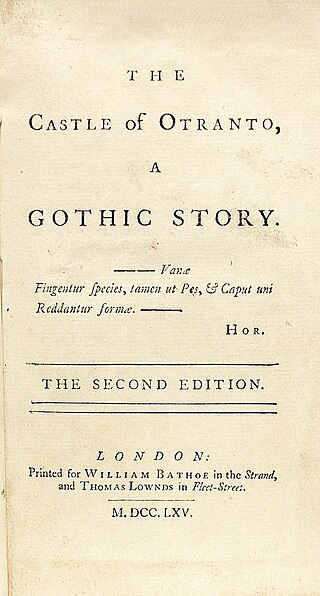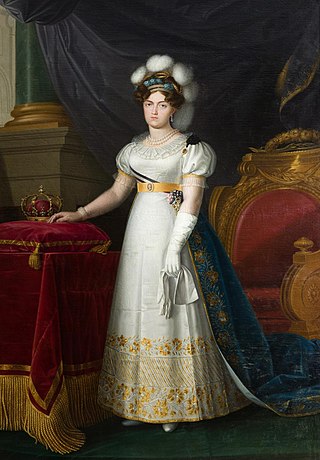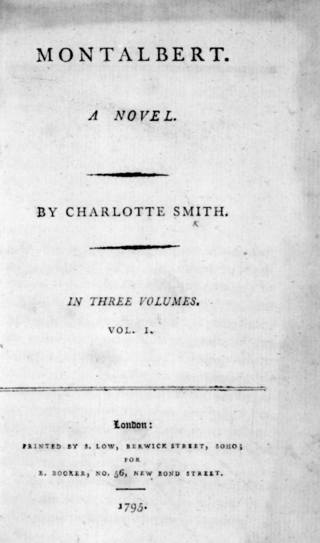
Ann Radcliffe was an English novelist and a pioneer of Gothic fiction. Her technique of explaining apparently supernatural elements in her novels has been credited with gaining respectability for Gothic fiction in the 1790s. Radcliffe was the most popular writer of her day and almost universally admired; contemporary critics called her the "mighty enchantress" and the Shakespeare of romance-writers, and her popularity continued through the 19th century. Interest in Radcliffe and her work has revived in the early 21st century, with the publication of three biographies.

Constance I was reigning Queen of Sicily from 1194–98, jointly with her spouse from 1194 to 1197, and with her infant son Frederick II, Holy Roman Emperor, in 1198. She is particularly notable for her actions against her own family, the Norman kings of Sicily; she played an important role in the end of the Hauteville presence in Sicily. She was also Holy Roman Empress and later Dowager by marriage to Henry VI, Holy Roman Emperor.

Francis I of the Two Sicilies was King of the Two Sicilies from 1825 to 1830 and regent of the Kingdom of Sicily from 1806 to 1814.

The Monk: A Romance is a Gothic novel by Matthew Gregory Lewis, published in 1796 across three volumes. Written early in Lewis's career, it was published before he turned twenty, and he withheld his name from the first edition. It tells the story of a virtuous monk who gives into his lustful urges, setting off a chain of events that leave him damned. It is a prime example of the type of Gothic that specializes in horror.

The Castle of Otranto is a novel by Horace Walpole. First published in 1764, it is generally regarded as the first gothic novel. In the second edition, Walpole applied the word 'Gothic' to the novel in the subtitle – A Gothic Story. Set in a haunted castle, the novel merged medievalism and terror in a style that has endured ever since. The aesthetic of the book has shaped modern-day gothic books, films, art, music, and the goth subculture.

Matthew Gregory Lewis was an English novelist and dramatist, whose writings are often classified as "Gothic horror". He was frequently referred to as "Monk" Lewis, because of the success of his 1796 Gothic novel The Monk. He also worked as a diplomat, politician and an estate owner in Jamaica.

The Italian, or the Confessional of the Black Penitents (1796) is a Gothic novel written by the English author Ann Radcliffe. It is the last book Radcliffe published during her lifetime. The Italian has a dark, mysterious, and somber tone which fixates on the themes of love, devotion, and persecution during the time period of Holy Inquisition. The novel deals with issues prevalent at the time of the French Revolution, such as religion, aristocracy, and nationality. Radcliffe's renowned use of veiled imagery is considered to have reached its height of sophistication and complexity in The Italian; concealment and disguise are central motifs of the novel. The novel is noted for its extremely effective antagonist, Father Schedoni, who influenced the Byronic characters of Victorian literature.

The Mysteries of Udolpho is a Gothic romance novel by Ann Radcliffe, which appeared in four volumes on 8 May 1794 from G. G. and J. Robinson of London. Her fourth and most popular novel, The Mysteries of Udolpho tells of Emily St. Aubert, who suffers misadventures that include the death of her mother and father, supernatural terrors in a gloomy castle, and machinations of Italian brigand Signor Montoni. It is often cited as an archetypal example of the Gothic novel.

Maria Isabella of Spain was Queen of the Two Sicilies from 4 January 1825 until 8 November 1830 as the wife of Francis I of the Two Sicilies.

Maria Josepha Amalia of Saxony was Queen of Spain as the third wife of King Ferdinand VII of Spain. She was the youngest daughter of Prince Maximilian of Saxony (1759–1838) and his first wife, Princess Carolina of Parma (1770–1804), daughter of Ferdinand I, Duke of Parma. She was a member of the house of Wettin.

Maria Clementina of Austria was an Austrian archduchess and the tenth child and third daughter of Leopold II, Holy Roman Emperor and Maria Luisa of Spain. In 1797 she married her double first cousin Prince Francis, Duke of Calabria, heir to the kingdoms of Naples and Sicily. She was modest, well educated and kind, becoming popular in her adoptive country. Afflicted with frail health, she died of tuberculosis, age twenty four. Her only surviving child was Princess Caroline, Duchess of Berry.

The Romance of the Forest is a Gothic novel by Ann Radcliffe that was first published in 1791. It combines an air of mystery and suspense with an examination of the tension between hedonism and morality. The novel was her first major success, going through four editions in its first three years, and establishing her reputation as a leading figure in the Gothic romance genre.

Bungay Castle is a gothic novel by Elizabeth Bonhôte, first published in 1797. It is set loosely in the thirteenth century around the First Barons' War, and follows the fortunes of the fictional De Morney family at the real Bungay Castle in Suffolk. Bonhôte's husband purchased the ruins of this castle in 1791. The novel was published by William Lane's Minerva Press. The core themes of the novel are conservative and pro-monarchic.
Eliza Parsons was an English Gothic novelist, best known for The Castle of Wolfenbach (1793) and The Mysterious Warning (1796). These are two of the seven Gothic titles recommended as reading by a character in Jane Austen's novel Northanger Abbey.

The Castle of Wolfenbach (1793) is the most famous novel written by the English Gothic novelist Eliza Parsons. First published in two volumes in 1793, it is among the seven "horrid novels" recommended by the character Isabella Thorpe in Jane Austen's novel Northanger Abbey and an important early work in the genre, predating Ann Radcliffe's The Mysteries of Udolpho and Matthew Lewis's The Monk.
Dear creature! How much I am obliged to you; and when you have finished Udolpho, we will read The Italian together; and I have made out a list of ten or twelve more of the same kind for you.
Have you, indeed! How glad I am! What are they all?
I will read you their names directly; here they are, in my pocketbook. Castle of Wolfenbach, Clermont, Mysterious Warnings, Necromancer of the Black Forest, Midnight Bell, Orphan of the Rhine, and Horrid Mysteries. Those will last us some time.
Yes, pretty well; but are they all horrid, are you sure they are all horrid?
The Orphan of the Rhine is a gothic novel by Eleanor Sleath, listed as one of the seven "horrid novels" by Jane Austen in her novel Northanger Abbey.
Ida Julia Pollock was a British writer of several short-stories and over 125 romance novels that were published under her married name, Ida Pollock, and under a number of different pseudonyms: Joan M. Allen; Susan Barrie, Pamela Kent, Averil Ives, Anita Charles, Barbara Rowan, Jane Beaufort, Rose Burghley, Mary Whistler and Marguerite Bell. She sold millions of copies over her 90-year career. She has been referred to as the "world's oldest novelist" who was still active at 105 and continued writing until her death. On the occasion of her 105th birthday, Pollock was appointed honorary vice-president of the Romantic Novelists' Association, having been one of its founding members.
Anne Ker was an English writer who published six novels between 1799 and 1817. She aimed for commercial success, writing in the popular Romance and Gothic genres.
The eighteenth-century Gothic novel is a genre of Gothic fiction published between 1764 and roughly 1820, which had the greatest period of popularity in the 1790s. These works originated the term "Gothic" to refer to stories which evoked the sentimental and supernatural qualities of medieval romance with the new genre of the novel. After 1820, the eighteenth-century Gothic novel receded in popularity, largely overtaken by the related genre of historical fiction as pioneered by Walter Scott. The eighteenth-century Gothic was also followed by new genres of Gothic fiction like the Victorian penny dreadful.

Montalbert (1795) is a novel by Charlotte Smith. The story is set in England and Italy in 1782 and 1783, with the 1783 Calabrian earthquakes playing a role in the narrative. The novel responds to Ann Radcliffe's famous Gothic novel A Sicilian Romance (1790), especially through its plot of a disenfranchised young woman seeking her lost mother.















